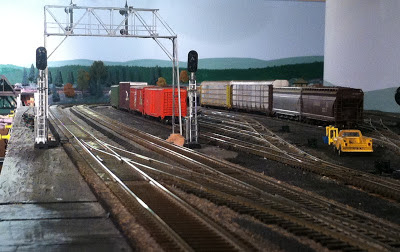What a major change to the feel of the space! Suddenly, there is a sense of distance, and the whole space to me feels much larger from this one simple change.
After painting the distant hills around the whole layout, I selected a medium green for the base coat of the closer hills, in the places on the layout that will need closer hills - namely, the M&E. This green is too consistent to stand alone. It will just be the first coat, intended to suggest the shaded leaves in the forest canopy. At least one more pass will come soon with a lighter, more yellow green color, applied unevenly, to suggest highlights and leaves on the surface of the canopy. I also plan to paint clear areas with rows, to suggest distant farm fields.
Even with that said, however, when viewed from a distance, I am still excited with the illusion that the backdrop now provides, even with just these simple shapes painted onto the backdrop. Here's a quick snapshot looking west at CP280, with the new signal bridge being test-fit as well. The backdrop in view here is the same as the area above:
Enjoy the start of the summer - more progress coming soon!
~RGDave





